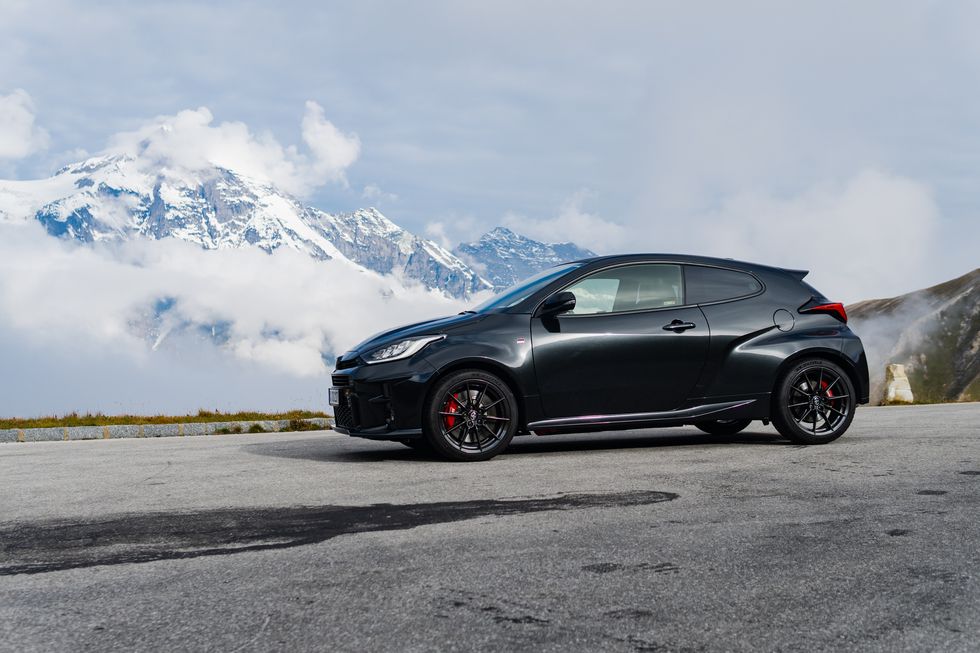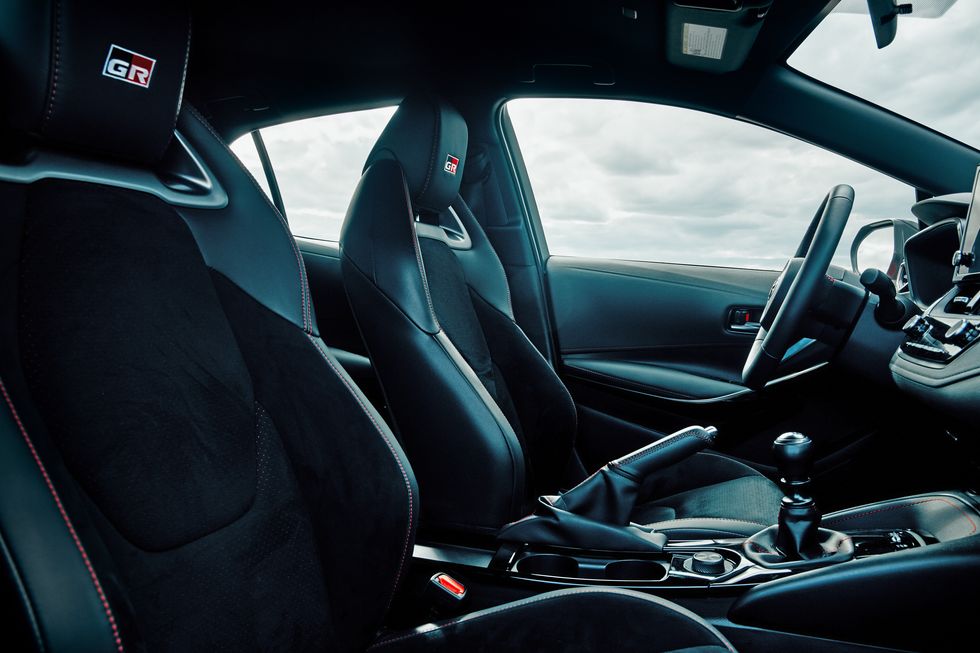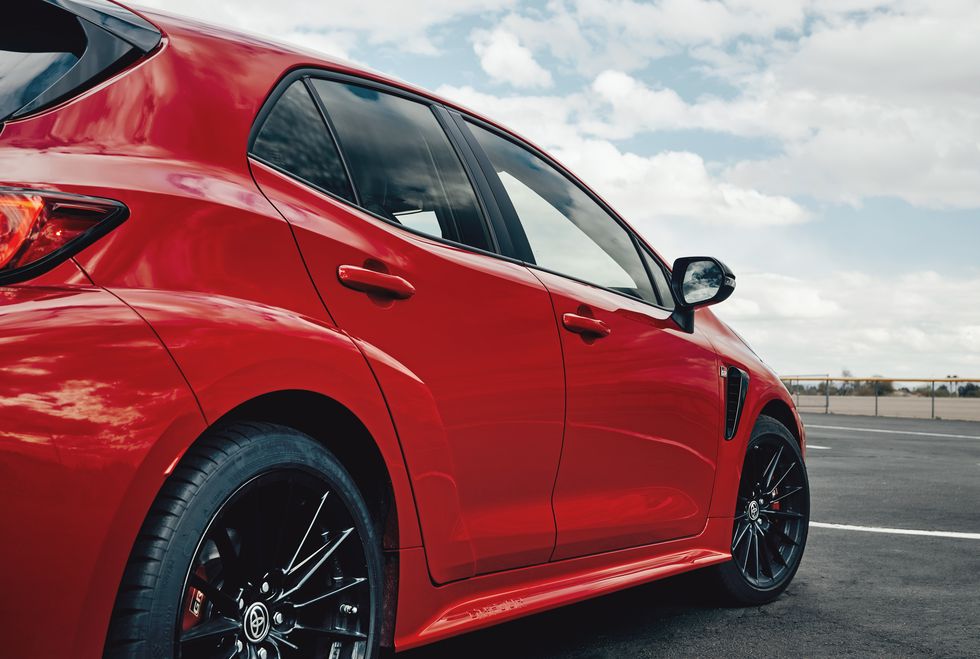In terms of skills relating to design, I have few. I can’t draw or model things with clay. I can’t paint. Hell, I can barely color. My personal style is a dark-colored t-shirt and a pair of jeans, almost exclusively worn with sneakers. I am in no way qualified to professionally critique design. That said, I do have eyes, and I know when I like something and when I don’t like something.
The GR Corolla is one of the weird ones, a car that makes a fantastic initial impression but falls apart the more you stare at it. And I think a lot of it has to do with how it was brought to market: Toyota may have developed it at the same time as the Yaris, but it’s not a homologation special.
The GR Yaris, if you need reminding, was a true homologation special for Toyota to take the Yaris rallying. It shares little with the regular Yaris for sale in countries other than the U.S., besides the name. What you get is a 3-door b-segment hatch on a Frankensteined combination of the Yaris and wider Corolla platform with a 1.6-liter 3-cylinder engine and 268 hp, all going through a six-speed manual to an advanced all-wheel-drive system. It’s a hell of a thing.
The body looks like a Yaris, but it’s lower, wider, and meaner. The interior looks like a Yaris, but it’s nicer, with better seats and updates to focus on the driver. By all accounts, it’s a hell of a thing.
Problem is, cars from that segment don’t sell in America. The only one available here is the Mitsubishi Mirage. But the demand was there for the GR Yaris in America. Petitions, forum posts, and general excitement led Toyota to believe there was a market for a hot hatch in the U.S. They would have needed to homologate the Yaris, which involves plenty of crash tests and exorbitant amounts of money. Why do that when a car that shares parts of the Yaris’s DNA is already available here?
So a fast Corolla it was. There were some gains over the GR Yaris, namely a power boost to 300 hp and the addition of the hardcore Morizo trim, with no backseats, Sport Cup 2 tires, and other track-focused goodies, but otherwise this is the GR Yaris with a bigger body and more weight to carry around.
And about that body. At first glance, it looks the part, all chunky flares and wide grilles. But then you spend a little more time looking at it, and something doesn’t feel right. It might not help that I was looking at it next to a Civic Type R, which is just a damn fine-looking car, but it was apparent that the GR Corolla wasn’t something Toyota planned for when this Corolla debuted.
It’s all incongruous. Everything looks tacked on. The flares at the front and rear seem to give it more of an illusion of width than actual presence. Then there’s the hood, which starts off low, then suddenly gets too tall for no apparent reason. The longer you stare at it, the more it looks like the proportions are off, that it’s both too short and too wide for how tall it is. It starts to look more like a Pep Boys special than something that came from the factory.
Now, you might be saying that there are plenty of cars that have tacked-on fenders or box flares, and those look good. You might own a GR Corolla and think I’m a moron. All fair. Thing is, the GR Yaris is a cohesive design. The flares and changes aren’t tacked on to an existing shell, this is an entirely new shell that was built for the Yaris, in the process transforming it into one of the meanest, most aggressive-looking small hot hatches of all time. The GR Corolla is a four-door Corolla hatch that went down the line at Toyota’s high-tech Motomachi plant–the same plant that builds low-volume models for the brand like the Century, Lexus LC, and the GR Yaris–and was modified to become more aggressive with flares, grilles, and other such.
It just doesn’t look cohesive, like Toyota forgot they had to build the car and hacked something together at the last minute. And because of that, it makes the GR Corolla, with its excellent drivetrain and driving dynamics, less special than the GR Yaris or the Civic Type R.

Editor-at-Large
Travis is an editor at Road & Track. He was previously the Editor-in-Chief of Jalopnik.com and is a little too fond of the Mazda Miata.
In terms of skills relating to design, I have few. I can’t draw or model things with clay. I can’t paint. Hell, I can barely color. My personal style is a dark-colored t-shirt and a pair of jeans, almost exclusively worn with sneakers. I am in no way qualified to professionally critique design. That said, I do have eyes, and I know when I like something and when I don’t like something.
The GR Corolla is one of the weird ones, a car that makes a fantastic initial impression but falls apart the more you stare at it. And I think a lot of it has to do with how it was brought to market: Toyota may have developed it at the same time as the Yaris, but it’s not a homologation special.
The GR Yaris, if you need reminding, was a true homologation special for Toyota to take the Yaris rallying. It shares little with the regular Yaris for sale in countries other than the U.S., besides the name. What you get is a 3-door b-segment hatch on a Frankensteined combination of the Yaris and wider Corolla platform with a 1.6-liter 3-cylinder engine and 268 hp, all going through a six-speed manual to an advanced all-wheel-drive system. It’s a hell of a thing.
The body looks like a Yaris, but it’s lower, wider, and meaner. The interior looks like a Yaris, but it’s nicer, with better seats and updates to focus on the driver. By all accounts, it’s a hell of a thing.
Problem is, cars from that segment don’t sell in America. The only one available here is the Mitsubishi Mirage. But the demand was there for the GR Yaris in America. Petitions, forum posts, and general excitement led Toyota to believe there was a market for a hot hatch in the U.S. They would have needed to homologate the Yaris, which involves plenty of crash tests and exorbitant amounts of money. Why do that when a car that shares parts of the Yaris’s DNA is already available here?
So a fast Corolla it was. There were some gains over the GR Yaris, namely a power boost to 300 hp and the addition of the hardcore Morizo trim, with no backseats, Sport Cup 2 tires, and other track-focused goodies, but otherwise this is the GR Yaris with a bigger body and more weight to carry around.
And about that body. At first glance, it looks the part, all chunky flares and wide grilles. But then you spend a little more time looking at it, and something doesn’t feel right. It might not help that I was looking at it next to a Civic Type R, which is just a damn fine-looking car, but it was apparent that the GR Corolla wasn’t something Toyota planned for when this Corolla debuted.
It’s all incongruous. Everything looks tacked on. The flares at the front and rear seem to give it more of an illusion of width than actual presence. Then there’s the hood, which starts off low, then suddenly gets too tall for no apparent reason. The longer you stare at it, the more it looks like the proportions are off, that it’s both too short and too wide for how tall it is. It starts to look more like a Pep Boys special than something that came from the factory.
Now, you might be saying that there are plenty of cars that have tacked-on fenders or box flares, and those look good. You might own a GR Corolla and think I’m a moron. All fair. Thing is, the GR Yaris is a cohesive design. The flares and changes aren’t tacked on to an existing shell, this is an entirely new shell that was built for the Yaris, in the process transforming it into one of the meanest, most aggressive-looking small hot hatches of all time. The GR Corolla is a four-door Corolla hatch that went down the line at Toyota’s high-tech Motomachi plant–the same plant that builds low-volume models for the brand like the Century, Lexus LC, and the GR Yaris–and was modified to become more aggressive with flares, grilles, and other such.
It just doesn’t look cohesive, like Toyota forgot they had to build the car and hacked something together at the last minute. And because of that, it makes the GR Corolla, with its excellent drivetrain and driving dynamics, less special than the GR Yaris or the Civic Type R.

Editor-at-Large
Travis is an editor at Road & Track. He was previously the Editor-in-Chief of Jalopnik.com and is a little too fond of the Mazda Miata.
In terms of skills relating to design, I have few. I can’t draw or model things with clay. I can’t paint. Hell, I can barely color. My personal style is a dark-colored t-shirt and a pair of jeans, almost exclusively worn with sneakers. I am in no way qualified to professionally critique design. That said, I do have eyes, and I know when I like something and when I don’t like something.
The GR Corolla is one of the weird ones, a car that makes a fantastic initial impression but falls apart the more you stare at it. And I think a lot of it has to do with how it was brought to market: Toyota may have developed it at the same time as the Yaris, but it’s not a homologation special.
The GR Yaris, if you need reminding, was a true homologation special for Toyota to take the Yaris rallying. It shares little with the regular Yaris for sale in countries other than the U.S., besides the name. What you get is a 3-door b-segment hatch on a Frankensteined combination of the Yaris and wider Corolla platform with a 1.6-liter 3-cylinder engine and 268 hp, all going through a six-speed manual to an advanced all-wheel-drive system. It’s a hell of a thing.
The body looks like a Yaris, but it’s lower, wider, and meaner. The interior looks like a Yaris, but it’s nicer, with better seats and updates to focus on the driver. By all accounts, it’s a hell of a thing.
Problem is, cars from that segment don’t sell in America. The only one available here is the Mitsubishi Mirage. But the demand was there for the GR Yaris in America. Petitions, forum posts, and general excitement led Toyota to believe there was a market for a hot hatch in the U.S. They would have needed to homologate the Yaris, which involves plenty of crash tests and exorbitant amounts of money. Why do that when a car that shares parts of the Yaris’s DNA is already available here?
So a fast Corolla it was. There were some gains over the GR Yaris, namely a power boost to 300 hp and the addition of the hardcore Morizo trim, with no backseats, Sport Cup 2 tires, and other track-focused goodies, but otherwise this is the GR Yaris with a bigger body and more weight to carry around.
And about that body. At first glance, it looks the part, all chunky flares and wide grilles. But then you spend a little more time looking at it, and something doesn’t feel right. It might not help that I was looking at it next to a Civic Type R, which is just a damn fine-looking car, but it was apparent that the GR Corolla wasn’t something Toyota planned for when this Corolla debuted.
It’s all incongruous. Everything looks tacked on. The flares at the front and rear seem to give it more of an illusion of width than actual presence. Then there’s the hood, which starts off low, then suddenly gets too tall for no apparent reason. The longer you stare at it, the more it looks like the proportions are off, that it’s both too short and too wide for how tall it is. It starts to look more like a Pep Boys special than something that came from the factory.
Now, you might be saying that there are plenty of cars that have tacked-on fenders or box flares, and those look good. You might own a GR Corolla and think I’m a moron. All fair. Thing is, the GR Yaris is a cohesive design. The flares and changes aren’t tacked on to an existing shell, this is an entirely new shell that was built for the Yaris, in the process transforming it into one of the meanest, most aggressive-looking small hot hatches of all time. The GR Corolla is a four-door Corolla hatch that went down the line at Toyota’s high-tech Motomachi plant–the same plant that builds low-volume models for the brand like the Century, Lexus LC, and the GR Yaris–and was modified to become more aggressive with flares, grilles, and other such.
It just doesn’t look cohesive, like Toyota forgot they had to build the car and hacked something together at the last minute. And because of that, it makes the GR Corolla, with its excellent drivetrain and driving dynamics, less special than the GR Yaris or the Civic Type R.

Editor-at-Large
Travis is an editor at Road & Track. He was previously the Editor-in-Chief of Jalopnik.com and is a little too fond of the Mazda Miata.
In terms of skills relating to design, I have few. I can’t draw or model things with clay. I can’t paint. Hell, I can barely color. My personal style is a dark-colored t-shirt and a pair of jeans, almost exclusively worn with sneakers. I am in no way qualified to professionally critique design. That said, I do have eyes, and I know when I like something and when I don’t like something.
The GR Corolla is one of the weird ones, a car that makes a fantastic initial impression but falls apart the more you stare at it. And I think a lot of it has to do with how it was brought to market: Toyota may have developed it at the same time as the Yaris, but it’s not a homologation special.
The GR Yaris, if you need reminding, was a true homologation special for Toyota to take the Yaris rallying. It shares little with the regular Yaris for sale in countries other than the U.S., besides the name. What you get is a 3-door b-segment hatch on a Frankensteined combination of the Yaris and wider Corolla platform with a 1.6-liter 3-cylinder engine and 268 hp, all going through a six-speed manual to an advanced all-wheel-drive system. It’s a hell of a thing.
The body looks like a Yaris, but it’s lower, wider, and meaner. The interior looks like a Yaris, but it’s nicer, with better seats and updates to focus on the driver. By all accounts, it’s a hell of a thing.
Problem is, cars from that segment don’t sell in America. The only one available here is the Mitsubishi Mirage. But the demand was there for the GR Yaris in America. Petitions, forum posts, and general excitement led Toyota to believe there was a market for a hot hatch in the U.S. They would have needed to homologate the Yaris, which involves plenty of crash tests and exorbitant amounts of money. Why do that when a car that shares parts of the Yaris’s DNA is already available here?
So a fast Corolla it was. There were some gains over the GR Yaris, namely a power boost to 300 hp and the addition of the hardcore Morizo trim, with no backseats, Sport Cup 2 tires, and other track-focused goodies, but otherwise this is the GR Yaris with a bigger body and more weight to carry around.
And about that body. At first glance, it looks the part, all chunky flares and wide grilles. But then you spend a little more time looking at it, and something doesn’t feel right. It might not help that I was looking at it next to a Civic Type R, which is just a damn fine-looking car, but it was apparent that the GR Corolla wasn’t something Toyota planned for when this Corolla debuted.
It’s all incongruous. Everything looks tacked on. The flares at the front and rear seem to give it more of an illusion of width than actual presence. Then there’s the hood, which starts off low, then suddenly gets too tall for no apparent reason. The longer you stare at it, the more it looks like the proportions are off, that it’s both too short and too wide for how tall it is. It starts to look more like a Pep Boys special than something that came from the factory.
Now, you might be saying that there are plenty of cars that have tacked-on fenders or box flares, and those look good. You might own a GR Corolla and think I’m a moron. All fair. Thing is, the GR Yaris is a cohesive design. The flares and changes aren’t tacked on to an existing shell, this is an entirely new shell that was built for the Yaris, in the process transforming it into one of the meanest, most aggressive-looking small hot hatches of all time. The GR Corolla is a four-door Corolla hatch that went down the line at Toyota’s high-tech Motomachi plant–the same plant that builds low-volume models for the brand like the Century, Lexus LC, and the GR Yaris–and was modified to become more aggressive with flares, grilles, and other such.
It just doesn’t look cohesive, like Toyota forgot they had to build the car and hacked something together at the last minute. And because of that, it makes the GR Corolla, with its excellent drivetrain and driving dynamics, less special than the GR Yaris or the Civic Type R.

Editor-at-Large
Travis is an editor at Road & Track. He was previously the Editor-in-Chief of Jalopnik.com and is a little too fond of the Mazda Miata.


















